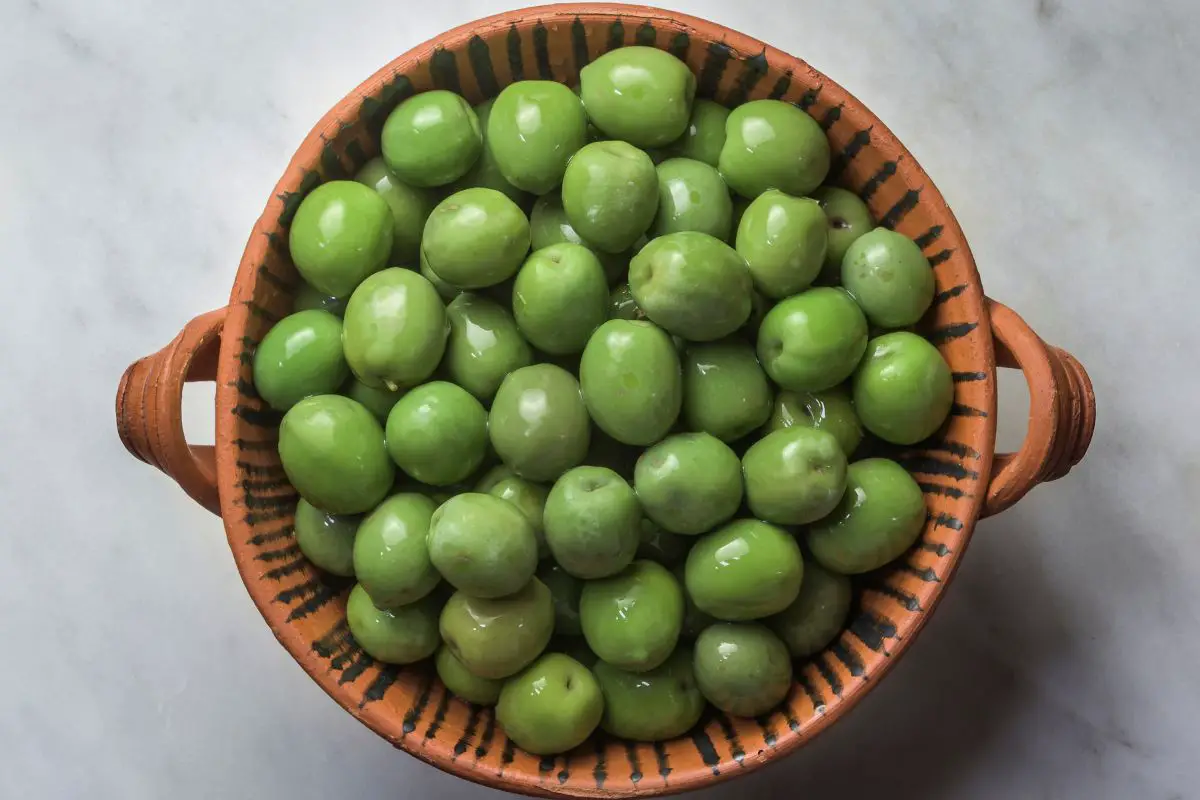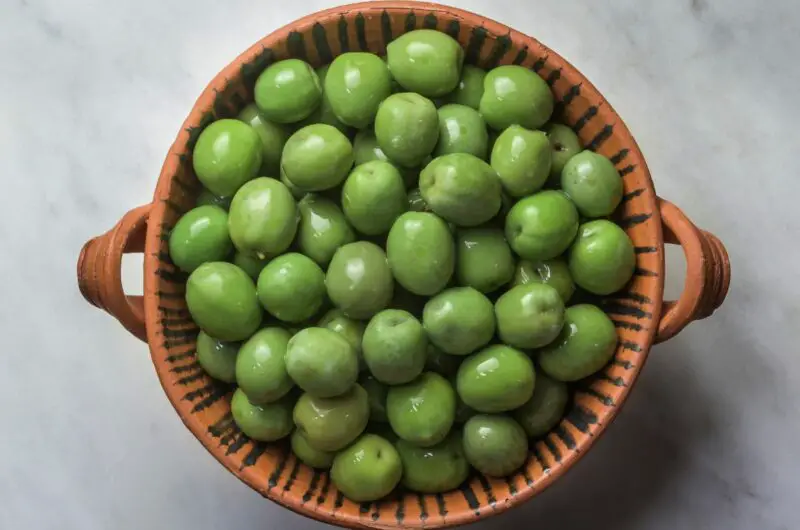Olives may be an acquired taste, but if you don’t mind the potent flavor of these little fruits, they can make a great inclusion to a wide assortment of different dishes. One of the most unique olives that you can try is the Castelvetrano olive.
If you aren’t able to get your hands on any Castelvetrano olives, don’t panic. There are lots of different substitutes that you can use instead of these olives.
These substitutes include other well-liked olive varieties, including Picholine olives.

What Are Castelvetrano Olives?
Castelvetrano olives are a type of olive that originates from Sicily, Italy. These olives have a bright green appearance. In terms of taste, the Castelvetrano olive tends to have a salty and nutty taste. This taste can also be somewhat buttery.
This olive variety is versatile and can be used in many different ways. For instance, it can be used as an addition to a martini. They are also commonly used as a pizza topping or salad ingredient.
If you love the acquired taste of olives, you can also consume them as snacks.
8 Castelvetrano Olives Substitutes
1. Manzanilla Olives
The first substitute that you can try using rather than Castelvetrano olives is the Manzanilla olive. This variety originates from Seville, Spain. Manzanilla olives are widely used in food preparation, predominantly to make olive oil.
The Manzanilla olive is a superb substitute for the Castelvetrano olive because they have a similar crispy texture. Both of these olive varieties have a nutty and meaty flavor that makes them a good stand-in for one another.
Though Manzanilla olives are one of the top substitutes for Castelvetrano olives, they have a pungent bitter taste. As a result, they will not taste the same as each other. However, this substitute will work especially well in salads and antipasto.
2. Capers
Capers are similar to olives, as they have a comparable flavor profile. However, they are not a variety of olive. Instead, capers come from the caper bush, where they are farmed as immature flower buds. Like olives, capers are grown across the Mediterranean.
In terms of taste, capers have a salty and tangy taste with a lemony hint. The taste and texture of a caper are comparable to Castelvetrano olives. Yet, it will give dishes a uniquely lemony taste.
Pickled capers are a good alternative to olives, as they tend to be lower in calories and will have a long shelf life. They will have a vinegary flavor that is comparable to the taste of olives.
It may be worth using a smaller portion of capers when substituting them for Castelvetrano olives.
3. Picholine Olives
Picholine olives are perhaps the best substitute for Castelvetrano olives, as they are perhaps the most similar to this variety. Additionally, Picholine olives are popular among lovers of these fruits. They are known for having a sharp and fragrant flavor.
Another benefit of using the Picholine olive is that they tend to be cheaper than the Castelvetrano. Therefore, you won’t have to spend a fortune on ingredients to make a luxurious meal.
Picholine olives can be used in the same quantities as Castelvetrano olives. Just bear in mind that the texture of this substitute will be a little crispier.
4. Ligurian Olives
Up next, you can also use Ligurian olives as a replacement for Castelvetrano olives. They have an indulgent creamy texture. When you eat these Ligurian olives as part of a salad or sandwich, they are bound to melt in your mouth.
Ligurian olives have a herbaceous taste that is quite sweet and tangy. They have a milder flavor than Castelvetrano olives, but will still make a pleasant substitute if you don’t mind eating something a little less potent.
Ligurian olives also have a bright appearance that will enhance the aesthetics of whatever dish you are making.
5. Kalamata Olives
If you have a passion for Greek cuisine, Kalamata olives are an ideal replacement for Castlvetrano olives. Named after Kalamata, these olives originate from Greece. They work wonderfully in Mediterranean salads, pasta dishes, and as a pizza topping.
It is the meaty taste of the Kalamata olive that makes it a versatile ingredient. This meaty flavor is what results in Kalamata olives being suitable substitutes for Castelvetrano olives.
Yet, the Kalamata olive has a slightly stronger flavor, which means that it can overpower dishes. To avoid this, you may wish to reduce the number of Kalamata olives that you are using.
Just bear in mind that the Kalamata olive looks noticeably different from the Castelvetrano olive, as it has a significantly darker hue.
6. Gaeta Olives
Gaeta olives are often compared to Kalamata olives, as they share a similar texture, appearance, and flavor profile.
These pink-hued olives are ideal for making a delicious tapenade, which is a type of olive-based spread. Moreover, Gaeta olives are widely used as appetizers.
Gaeta olives are tart and salty. They can also taste quite sweet, though the aftertaste is bitter.
Though they have a noticeably different flavor from Castelvetrano olives, they are close enough in flavor that you can easily use them as a substitute. Gaeta olives may also be used as a replacement for Kalamata olives if you are unable to get your hands on them.
7. Nyons Olives
Nyons olives are renowned for their dark hue. They have a dark shade of brown or purple that is remarkably close to being black. These small and dark olives are grown in South France.
These aromatic olives are commonly drizzled in Provençal olive oil to boost their flavor. They are mildly bitter, making the Nyons olives a decent replacement for Castelvetrano olives. Not to mention, they have a meaty quality that makes them fairly flexible.
8. Cerignola Olives
Last but not least, Cerignola olives are phenomenally popular in Italian cuisine. One of the main differences between the Cerignola olive and other varieties is that it tends to be a little larger.
Cerignola olives tend to be mild, making them a viable option for people who don’t enjoy overpowering olives. They have a delightful taste that can be described as meaty and buttery. They are an excellent inclusion to pasta dishes, as they will add a unique flavor.
When swapping Castelvetrano olives with Cerignola olives, it is worth using a smaller portion due to their large size.
Final Thoughts
If you are following a recipe that requires the use of Castelvetrano olives, there are lots of different substitutes that you can use if you are unable to acquire them.
Though these olive varieties may not have the exact same flavor and texture as Castelvetrano olives, they will offer similar qualities to whatever dish you are making.
8 Castelvetrano Olives Substitutes
Course: Substitutes4
servings30
minutes40
minutes300
kcalIngredients
Manzanilla Olives
Capers
Picholine Olives
Ligurian Olives
Kalamata Olives
Gaeta Olives
Nyons Olives
Cerignola Olives
Directions
- Decide on what substitute you need
- Pick a substitute from the list above
- Read what you need to substitute with
- Create the recipe and enjoy
Recipe Video
https://youtu.be/cWmGgjMkFfkVideo can’t be loaded because JavaScript is disabled: Warmed Castelvetrano olives with lemon & garlic (Vegan) (https://youtu.be/cWmGgjMkFfk)- What Exactly Do Chickpeas Taste Like? Is There A Distinct Flavor? - September 30, 2023
- Top 11 Low Carb Options at Sonic Drive-In for Keto Diet - September 30, 2023
- What Should You Serve Alongside Potato Salad? 8 Incredible Side Dishes - September 30, 2023











